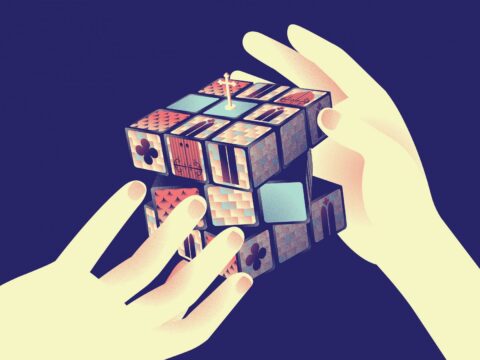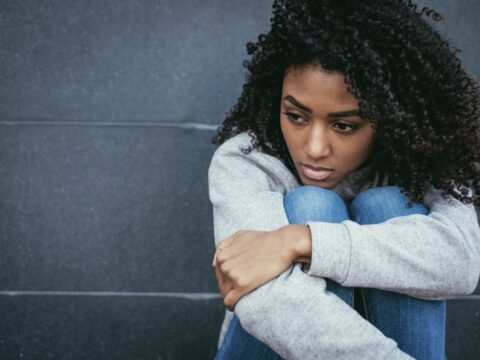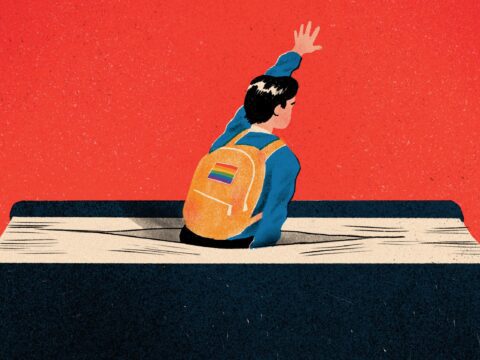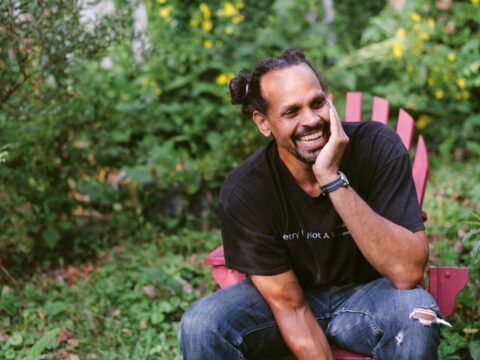Warning: This story contains descriptions of attempted suicide, which readers may find disturbing.
Afternoon sunlight dapples across a pink-and-white striped bedspread that matches the walls of my room in my family’s southern Ontario home. Tiny hairs bristle on the back of my neck as I hear my parents’ raised voices pierce through my bedroom door. I watch in my dresser mirror as plump tears slip down my baby-fat cheeks. I’m six years old, and I am consumed by despair.
Though our suburban starter home is as uniform as the rest on our block, it’s a free-for-all inside. My mom is perpetually working. When she’s at home, she’s mostly engaged in explosive battles with my stepdad, who spends his days watching TV and nurturing his opioid addiction. I try to stay small and quiet to avoid his mood swings, which easily splinter into physical violence aimed at me.
Today, watching my reflection, I have the chest-hollowing realization that I’ve failed to take care of my mother — to show her the dangers lurking in the man she married. I’ve also failed to take care of myself. I don’t have the language skills necessary to communicate the shocking depths of my emotions and convictions. All I know is that I want my misery to end. So I tie the belt of my pink terry cloth housecoat around the base of my throat, grip the ends and pull.
I had heard two stories of children who accidentally strangled themselves with their toys. One was in a made-for-TV movie. The second was from my mother, who shared her anxiety about the hazards of toy hammocks after she heard about a young girl who choked to death. If strangling was lethal for those kids, I reason, maybe that is the solution to my problems.
As my airway constricts, panic reverberates through my body and my hands instinctively claw at the knotted belt, tearing it off. I curl into the fetal position on the carpet, and a swell of failure and loneliness washes over me. Can I not do anything right? Does anyone understand what I’m going through?
More than 20 years later, talking about my first suicide attempt is still difficult. Suicide carries enough stigma to keep me silent, but at such a young age? No one wants to hear about that. However, I’m driven to finally speak up because I know I’m not alone. Between 2000 and 2018, 652 children under the age of 14 died by suicide in this country. Six of those children were younger than nine.
While these figures may indicate a relative rarity, the Centre for Suicide Prevention points out that this may be due to misreporting. The Calgary-based non-profit runs workshops on the warning signs of suicidal ideation in children, including uninterest in previously enjoyed activities, new problems at school and developing multiple fears. In a case where there’s ambiguity over a minor’s death, a coroner might label the cause an accident to alleviate the family’s burden of having a child die by suicide.
These unclear statistics, and the lack of a co-ordinated national system ready to support kids with mental health issues, means children in Canada who struggle with thoughts of suicide have limited access to help. Until the health-care system puts an emphasis on prevention and early intervention programs or addresses structural inequities in children’s environments, kids like me will be left dealing with the long-term physical, mental and social consequences of under-treated childhood mental illness.
My family wasn’t aware of my early suicidal machinations, but they noticed behavioural quirks. To retain some sense of control as my abusive stepdad dominated our lives, I would hold my pee for hours on end. My bladder infections became so chronic that I had to be treated at SickKids in Toronto. Thanks to my drastic mood swings, I often heard caregivers repeat that Henry Wadsworth Longfellow refrain: “When she was good, / She was very good indeed, / But when she was bad, she was horrid.” Within a split second, I’d go from playing calmly to smashing everything in sight, screaming and crying at the top of my little lungs.
When I was eight in 1998, my mother brought me to a general practitioner in our rural Ontario town. He spent the appointment frowning as my mother described my moods before he announced they were likely an allergic reaction to chocolate or the artificial dye in candy. He didn’t administer an allergy test or refer me to a specialist. He just sent us on our way with new dietary restrictions. I don’t remember speaking during the visit — just staring at the doctor’s wiry knuckle hair. That interaction would be the extent of my childhood mental health treatment.
If he had done a little research, the doctor may have discovered some clues about my behaviour in a groundbreaking study. From 1995 to 1997, Kaiser Permanente, an American health organization, investigated the impact of abuse, neglect, parental drug use, violence and divorce on a child’s health in the Adverse Childhood Experiences Study (ACES). For each traumatic experience children are exposed to, they score an ACE point, up to a maximum of 10. The more ACE points a child has, the worse her or his physical and mental health are likely to be. Children with ACE scores of four or more are 12 times more likely to attempt suicide at some point in their life. (My ACE score is eight.) While the ACE study focused on long-term health, it emphasized the importance of early intervention in children’s health care.
According to a 2007 article published by the Society for Academic Emergency Medicine, many children attempt suicide for the same reason I did: to escape an unbearable environment or situation. Other reasons are also linked to early traumatic experiences such as divorce, the death of a parent, feeling unwanted by a caregiver, avoiding punishment or abuse, or simply seeking a happier, more comfortable place. “If you haven’t had a secure base or if you haven’t had a secure attachment relationship, your capacity to regulate your emotions and your nervous system is profoundly impacted,” says Ruth Lanius, professor of psychiatry at Western University in London, Ont. “If you add that history and then experience trauma on top of it, I think the results are much more devastating.”
To make matters more complex, children who come from households where there’s trauma or attachment disruptions may face other barriers to receiving treatment. While some of the more astute members of my extended family felt I could benefit from therapy, they had a real concern I might reveal some of the abuse and drug use in my house, and that could prompt a visit from the Children’s Aid Society (CAS). “I think the fear of CAS becoming involved is highly relevant,” says Lanius. “It’s all about keeping trauma secret.”
With the inherent secrecy surrounding childhood trauma and abuse, how can kids who are suffering become visible? Lanius believes education and co-ordination with school systems could be the answer. “Right now, a lot of [traumatized kids] are labelled as ‘bad children’ because teachers haven’t had the education. They don’t know that when a child is hyperaroused and always in fight-or-flight mode that they’re actually in a prolonged fight-or-flight response because of something that may be going on at home. Or the opposite extreme [occurs] where a child dissociates, numbs out and detaches.…Those kids may be labelled as the ‘lazy’ kids, the ‘uninterested’ kids.”
More on Broadview:
- How to take care of your mental health this winter
- How basement living can affect mental health
- Why it’s so hard to find affordable mental health care
Unfortunately, even if a child’s mental health concerns are identified, the Canadian health-care system hasn’t always been equipped to intervene. Historically, child development specialists believed children don’t possess a mature concept of death until about age 10, and hence couldn’t be truly suicidal before then. “In my experience, [suicide in children] has increasingly been a reality that I’ve had to contend with,” says Sheila Harms, associate chair of McMaster University’s department of psychiatry and behavioural neurosciences in Hamilton.
Children and their families might also face barriers accessing treatment in primary care settings, since not all family doctors have been taught to consider mental health concerns in children. “There are a lot of family physicians who trained 40 or 50 years ago who are still in practice,” says Nick Kates, chair of psychiatry and behavioural neurosciences at McMaster. “Having said that, I’ve been impressed by the ability and willingness of family physicians to adapt to new models and learn new skills.…I would say over the last 20 years, there have been very significant and important changes. Collaboration between mental health and primary care services is now seen as what should be an integral part of all practices.”
Even with growing awareness about children’s mental health needs, health-care funding doesn’t prioritize prevention. This is demonstrated in long wait times for children’s mental health care across the country. In Ontario, children can wait as long as two-and-a-half years to receive treatment. In a report released by Children’s Mental Health Ontario entitled “Kids Can’t Wait,” researchers estimated nearly 200,000 children with serious mental health issues have no contact with services.
By the time I turned 17, I was living nowhere and everywhere, sleeping in a different place each night. I had left home two years earlier after my relationship with my stepdad became too strained. I’d tried to kill myself at least a dozen times, graduating to increasingly dangerous methods with only my ineptitude saving me. Luckily, an aunt made a deal with me: she’d connect me to counselling and, if I went, I’d be allowed to crash at her place two nights a week. I jumped at the offer — the first of countless steps down a winding road to recovery.
The most frustrating aspect of writing this piece is seeing myself as a statistic. As a child from a low-income family, I was actually more at risk for suicidal thoughts than my more affluent peers. In fact, in a 2015 scorecard of mental health in children and youth in Ontario, researchers found those living in the lowest-income neighbourhoods had the highest rates of suicide.
There are other statistics that don’t apply to me but are equally troubling. For example, in a 2001 study in Canada, the United States and New Zealand, a third of young people between 14 and 21 who identified as gay, lesbian or bisexual reported having attempted suicide at least once. According to the Canadian government, between 2004 and 2008, children and youth in Inuit Nunangat were over 30 times more likely to die from suicide than youth in the rest of Canada.
On Nov. 21, 2019, Jaylyn Angus, age 10, died by suicide on Makwa Sahgaiehcan First Nation in Saskatchewan. Jaylyn was a kind-hearted daddy’s girl who loved the outdoors and animals, visiting her cousins and grandmas, and dancing at powwows. “She always wanted to come with us hunting,” says her stepmother, Dorothy Angus. “We’d get her up early in the morning, and there was no fussing whatsoever.”
Angus and Jaylyn’s father started raising her when she was 10 months old, eventually getting custody of her at age three. As Angus talks, it’s apparent how much she supported and provided a safe haven for Jaylyn. It’s also apparent how many questions she still holds around her daughter’s death. She goes over Jaylyn’s habits searching for red flags. As she got a little older, Jaylyn spent more time in her room on her tablet and was harder to talk to, but that’s true of a lot of kids, especially introverts. Jaylyn started dressing more masculine and cut her hair like a member of her favourite K-pop group, BTS, but none of that signalled a mental health crisis to her parents.
Angus wonders about Jaylyn’s time with her biological mom, which had been difficult and chaotic. And at five, Jaylyn was abused. “I reported it, and nothing was ever done,” says Angus. “That was one thing I think she carried with her all the time.”
In addition to Jaylyn, two other people from Angus’s community died by suicide in the same month, prompting the Makwa Sahgaiehcan First Nation to declare a state of crisis and call for long-term prevention strategies. Though counsellors are within the community now, Angus feels like after the initial media coverage, Jaylyn and the others who died have been largely forgotten. “It seems like nobody cares,” says Angus. “It’s like, ‘Oh, they’re gone. Move on.’ That’s it.… I just wish there was more help.”
Psychologist Jeffrey Ansloos is the Canada Research Chair in critical studies in Indigenous health and social action on suicide, and a member of Fisher River Cree Nation in Manitoba. He shared a perspective I’d never heard before on the suicide rates of Indigenous children: “Western psychological practice, in particular as it relates to issues around suicide or mental health, assumes that these are always the products of a psychological disorder.…Another way to look at mental health is to ask: Is the logic of the world around someone conducive to thriving? Is it irrational or is it realistic for someone to feel depressed in an environment that constantly reinforces questions of their value? I would say that’s actually not a disordered response. It’s a disordered environment.”
In addition, Ansloos illuminates how western mental health practices are entrenched in colonialism. He notes that the Diagnostic and Statistical Manual of Mental Disorders (DSM), often touted as psychiatry’s bible, refers to healthy functioning as someone’s ability to motivate themselves to get up in the morning and go to work or school. This fails to account for Indigenous people who might be more interested in contributing to their community or staying close to home than participating in the majority workforce, says Ansloos. “Those things, to me, suggest a clear bias that disadvantages and over-pathologizes Indigenous people.”
Considering this perspective, Ansloos would like to see a more integrated approach to mental health care. He calls for greater collaboration across health services, education, housing and food security to shift the prevalence of suicide rates in Indigenous children and youth. And he wants to include community members, advocates and youth in the decision-making.
The importance of this became clear to Ansloos during the suicide crisis in Attawapiskat, Ont., in 2016. A group of social workers and mental health professionals sent to the community asked youth what they needed to support their mental health. “The first things on this group of young people’s list were water purification and treatment centres, dust control, an ice rink, a recreation centre and the opportunity to meet with Elders regularly,” says Ansloos. Mental health services were included, but as item eight or nine. “It became so crystal clear to me how wise our young people are to the things that actually need changing in communities.”
“Another way to look at mental health is to ask: Is the logic of the world around someone conducive to thriving?”
Jeffrey Ansloos
Healing from childhood trauma is not a linear process. As I write this story, I realize I need to tend to the little girl in me who is still hurting, feeling lost and alone as she stands in front of her mirror. During a therapy session last September, my therapist suggested we use integrative psychotherapy to help me go back to the memory of my six-year-old self with the pink belt around her throat. This method is called “internal family systems” and has proved successful in treating post-traumatic stress disorder.
With coaching from my therapist, I imagine my grown-up self asking Little Me what she needs. Then I listen to her wail that she wants her stepdad to leave and that she misses who our mother used to be. I tell her I understand how she feels, how brave and capable she’s been. I rub her back, reassuring her. Then I ask if I can remove the tie around her neck. She nods.
“Is there something wrong with me?” Little Me asks.
“No,” I say. “There’s nothing wrong with you. You were born into tough circumstances, and everything you’re feeling is a normal reaction to your environment.”
My therapist suggests we take Little Me to a safe place, but first we should help her unburden all the emotions she’s experiencing so she doesn’t have to carry them anymore. I picture myself placing two magical boxes in front of Little Me — one for all of the good things she wants to bring with her (her animals, her grandparents, her teddy bear, her blanket) and one for all of the bad things we want to let go.
Together, we fill the second box with her inability to communicate her feelings, with her loneliness and confusion, with all the bad memories that cause her so much pain. Then we decide to burn the bad box and everything in it.
Standing there in my mind’s eye with Little Me watching all those emotions and memories turn to ash, I feel a lightness spreading across my chest and into my shoulders. When the fire burns out, I let Little Me dance and laugh in the smoking ashes, her shoes turning black with soot. When she’s ready to go, I sling her box of goodness over my shoulder and take her hand, as we walk off to a safer place.
If you are considering suicide, please reach out to Crisis Services Canada (1-833-456-4566 or crisisservicescanada.ca) or First Nations and Inuit Hope for Wellness Helpline (1-855-242-3310 or hopeforwellness.ca).
This feature first appeared in Broadview’s January/February 2021 issue with the title “Kids in crisis.”
Miranda Newman is a freelance writer in Toronto.
















Tears for you my sweet granddaughter. I’m sorry.
I am not surprised. Appeals for these types of criminal cases are difficult. Common cited case here is R. v. John McAughey, 2002 ONSC 2863, you can look it up online. The appeal was for a conviction of assault on a minor in Sprucedale, Ontario in 2000.